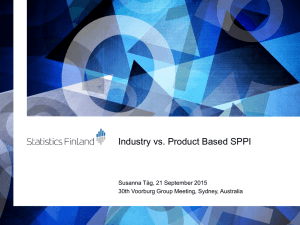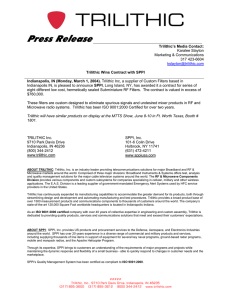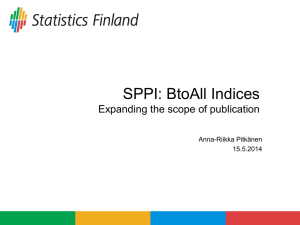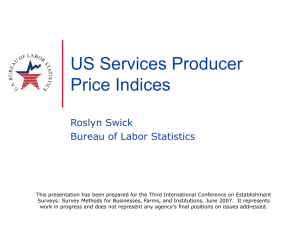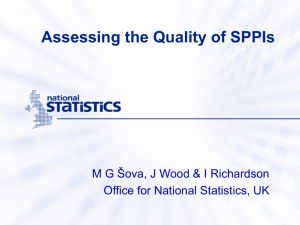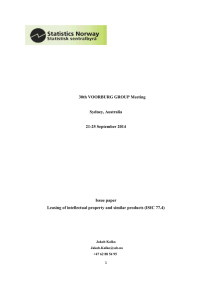Cross Cutting Topic: Industry vs. Product Based SPPI 30 Voorburg Group Meeting
advertisement
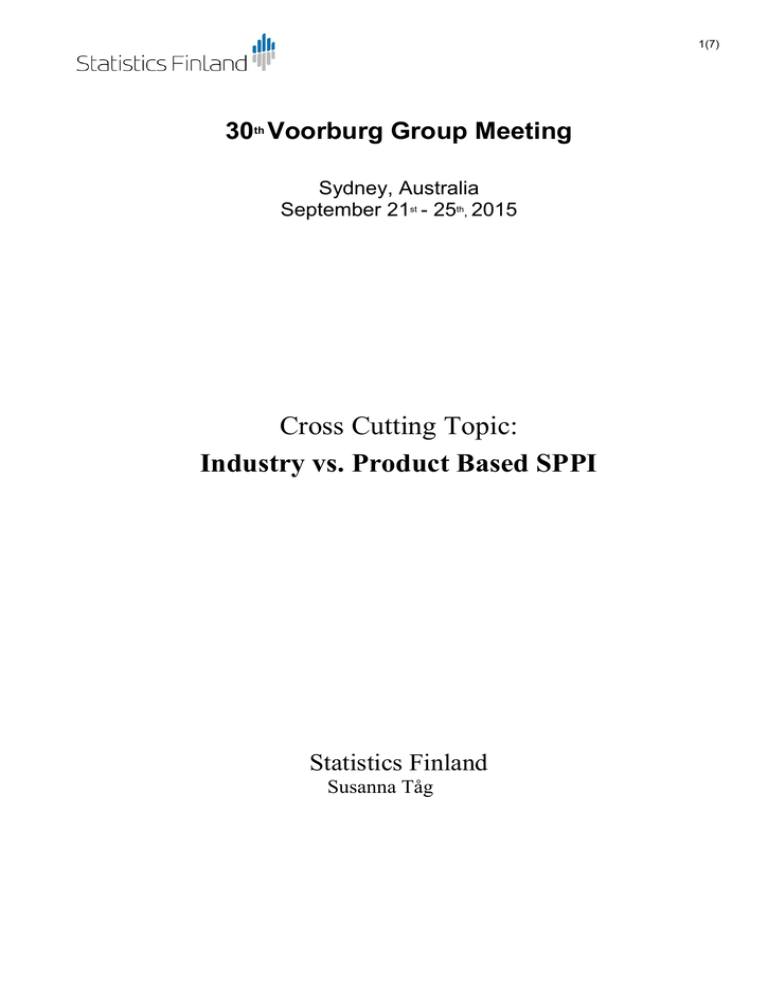
1(7) 30th Voorburg Group Meeting Sydney, Australia September 21st - 25th, 2015 Cross Cutting Topic: Industry vs. Product Based SPPI Statistics Finland Susanna Tåg 2(7) TABLE OF CONTENTS 1. INTRODUCTION ...................................................................... 3 2. DEFINITION OF INDUSTRY AND PRODUCT BASED SPPI ... 3 3. HOW IS THE INDUSTRY VS. PRODUCT BASED APPROACH HANDLED IN VARIOUS SPPIS? ........................ 4 4. IN WHAT INDUSTRIES IS THE CHOICE BETWEEN INDUSTRY VS. PRODUCT BASED APPROACHES ESPECIALLY PREVALENT?.................................................... 5 5. WHAT CHALLENGES DOES INDUSTRY VS. PRODUCT BASED APPROACH PRESENT TO FOLLOWING EXISTING PRODUCT CLASSIFICATIONS?............................ 6 6. HOW DOES INDUSTRY VS. PRODUCT BASED APPROACH IMPACT THE COUNTRY’S NATIONAL ACCOUNTS’ CALCULATION OF VOLUME OF SERVICES OUTPUTS?............................................................................... 6 REFERENCES ................................................................................... 7 3(7) 1. Introduction The choice between an industry and a product based services producer price index (SPPI) has been pointed out. For example, according to the second edition of Eurostat-OECD SPPI Guide it is preferred that SPPIs measure change in the prices of products, rather than industries. The purpose of this paper is to highlight a number of aspects when considering the composition of industry and/or product based SPPIs. The emphasis is on the practical side, and the thoughts presented in this paper are based on both some international guides and manuals as well as on the experiences of Statistics Finland (S)PPI team. 2. Definition of Industry and Product Based SPPI The question may arise what the difference between industry and product based SPPI actually is. Firstly, when it comes to an industry based index, a sample is drawn from business enterprises classified under specific industry. These sampled units produce output which is classified under that industry. Furthermore, enterprises might also produce something else that is classified under other industries in the international classification systems. In other words, enterprises can have output from secondary activities. In the case of industry based SPPI, at least in theory, all of the output of the sampled units is represented in the index, even secondary activity output. Secondly, as opposed to the industry based SPPI, product based indices are created from samples of products. In this case the indices describe development in the prices of certain types of services irrespective of the main industry of the enterprise. For example, if a service enterprise also produces goods, its goods production is excluded from the scope of the description of the SPPI. On the other hand, an enterprise that mainly produces industrial goods may also produce other services than manufacturing services, in which case its services production is included in the scope of the description of the SPPI. That is, the sample frame of SPPI covers all units producing relevant service activities whether these units are classified under the main industry or some other industry. Another question might also arise why the product based SPPI is preferred at least in SPPI Guide, as well as in Handbook on price and volume measures in national accounts and also in ESA2010. This is related to the primary objective of the SPPI. The SPPI serves two (or three) purposes that are usually not in conflict because they can often be reconciled in the SPPI development. If the primary objective for the development of an SPPI is to deflate national accounts data (or data on service production for volume indicator)1, then a product based SPPI would be preferred. However, if the SPPI serve primarily as a short-term indicator, then an industry based SPPI will be recommended. 1 This is, however, subject to the composition of data on production, i.e. value index, which is deflated by a price index. The structure of the value index and the price index should be comparable. 4(7) For the deflating purposes product based SPPI is preferred because the output of industries in most countries can typically be broken down into various products. This allows readily to derive measurements for industry output in volume terms. Furthermore, when calculating volume estimates of valueadded it is required to use double-deflation. This requires deflating the intermediate consumption of industries, which is again usually product based data. The changes in the composition of output have to be taken frequently into account in national accounts in order to estimate reliably price and volume development for industry outputs. That is the reason why having product SPPI available for deflation is more practical rather than using an industry based SPPI, which would require frequent re-weighting to match with the industry output in national accounts. It is also important to notice that CPIs and some other price indices measure change in the prices of products rather than industries. The industry based indices can normally be obtained by combining detailed product based indices using weights from e.g. structural business statistics or national accounts. All in all, as it is stated in SPPI Guide, product based SPPI provides more possibilities for combining various price index data for use in, e.g. balancing supply and use tables in the national account. As mentioned above, it should neither exclude the use of SPPI as a short-term indicator. 3. How Is the Industry vs. Product Based Approach Handled in Various SPPIs? Even though it is recommended to compile SPPIs on the product basis, in practice, due to limitations in the availability of detailed output data, the SPPI may be an industry based or even a mixture of industry and product based. It should be noticed that statistics in general, e.g. product based statistics on outputs, are less developed for service industries than for goods industries. Additionally, like the SPPI Guide points out, the choice between industry and product based SPPIs may be less important for services than for goods while the share of secondary production tends to be smaller in services than in goods. However, this is not necessary true for all service industries like industries with relatively high share of secondary production e.g. NACE 70.2 - Management consultancy activities. So, this should be studied by industry. In general, it can be concluded that the larger the share of industry turnover stemming from the production of secondary activities the stronger the argument for compiling product based SPPI. The more some service is produced as secondary activity in some other industry, the bigger share of the production of the service would be ignored in the industry based survey. Although, if the industry based survey should be rather extensive, this would not necessarily be the case. In addition, the former conclusion can be questioned if the development of prices differs clearly when some service is provided as principal production 5(7) falling under the same industrial class to the enterprise versus provided as secondary production. The pricing mechanism and, hence, the development of prices can differ between the industries where the service is provided. In theory, when economic actors have perfect information of markets, this should not occur because prices for some specific service should not diverge depending only on the origin of the industry. In practice, this issue could possibly be taken into consideration in some cases when compiling SPPI. 2 On the other hand, the resources for developing SPPIs are often rather limited which can lead to more like accepting the assumption of perfect competition in this matter. Thus, it may be reasonable to assume that prices of outputs follow prices of similar services wherever produced (as principal or secondary production) rather than prices of other outputs in the producing industry. 4. In What Industries Is the Choice between Industry vs. Product Based Approaches Especially Prevalent? As a general rule, acknowledging the restrictions mentioned in the previous chapter, the product based SPPI is recommended, especially, in the case of high share of industry turnover stemming from the production of secondary activities. The share of secondary activities can be studied using different kinds of data sources available, for example business services surveys, structural business surveys and input-output tables. Here are introduced some industries where the issue might be prevalent according to the Finnish data. It should be noticed that the situation may vary between countries and over the time. The following results are obtained by analysing input-out tables. According to the suggestive results the share of secondary production is relatively high (> 30 %) in the following industries (NACE): – – – – – – J59 - Motion picture, video and television programme production; sound recording and music publishing activities; M70.2 - Management consultancy activities; J62 - Computer programming, consultancy and related activities; I55 - Accommodation; J58 - Publishing activities and N82 - Office administrative, office support and other business support activities. For example, in the case of M70.2 - Management consultancy activities, there are several services which belong to secondary production. There are 2 See 2008 SNA, p. 303 about the price variation due to quality differences and ESA 2010, p. 294 about the quality, price and homogeneous products. 6(7) for instance production of computer consultancy activities, software publishing, accounting, bookkeeping and auditing activities, tax consultancy and computer facilities management activities in the industry. 5. What Challenges Does Industry vs. Product Based Approach Present to Following Existing Product Classifications? In order to compile product based SPPIs, a product classification should be detailed enough to constitute relatively homogeneous group of service products. Furthermore, the classification should fit to the activities undertaken in service sector. In practice, more detailed level of groups which may also be more suitable can be defined for the use of SPPI. These groups can be defined, for example, by specific survey, or they may also be based on the advice of the relevant industry representative organisations. 6. How Does Industry vs. Product Based Approach Impact the Country’s National Accounts’ Calculation of Volume of Services Outputs? As has been pointed out, the product based SPPI is recommended for deflation purposes. This is in line with the SNA/ESA, which prefers the GDP compilation based on the framework of supply and use tables. It means that data on output of industries are available by product groups and are not shown only as a sum of many types of products. However, if industry based SPPIs are only available, special attention need to be paid to weighting the price indices. The weights should be updated frequently to match with the industry output in national accounts. On the other hand, the composition of data on output of industries (by product groups) should be kept in mind. The availability and the level of detail of the data on industry output by product groups are subject to product based statistics on outputs which can be rather limited in the case of services. This affects also the use of product based SPPIs for deflation purposes, and also the development of new indices for SPPI, while the availability of representative sampling frame and weighting structure are also dependent on product based data. In order to enhance the situation stated above, detailed turnover data at as disaggregated a level as possible is required. For example, in Finland Business Services Statistics provide this kind of information but it does not cover all service industries or products. Hence, improvements would be required to get representative data for sampling and weighting of service products. As long as the detailed turnover data is missing or it does not give a comprehensive picture of service output, industry based SPPIs can be common. 7(7) References European Commission, IMF, OECD, UN and World Bank (eds.) (2009), System of National Accounts 2008, United Nations, New York. Available at: http://unstats.un.org/unsd/nationalaccount/docs/SNA2008.pdf Eurostat (2001), Handbook on price and volume measures in national accounts, European Union, Luxembourg. Available at: http://ec.europa.eu/eurostat/web/products-manuals-and-guidelines/-/KS-41-01-543 Eurostat (2013), European system of accounts - ESA 2010, European Union, Luxembourg. Available at: http://ec.europa.eu/eurostat/web/products-manuals-and-guidelines/-/KS-02-13-269 Eurostat, OECD (2014), Eurostat-OECD Methodological Guide for Developing Producer Price Indices for Services. Available at: http://ec.europa.eu/eurostat/web/products-manuals-and-guidelines/-/KS-04-14-661
